Established in 2006, Shopify is a one-stop solution that assists digital sellers in starting, running, and growing their online stores. It is specifically designed for anyone who owns or wants to own an eCommerce business.
Shopify has generated over $700 billion in sales since its inception.
Currently, Shopify’s total revenue stands at $4.9 billion, and its market share is 25% of the global e-commerce platform market.
Experts predict that Shopify merchants will have over 700 million customers to cater to In 2024.
We will uncover all about Shopify in this statistical guide through numbers. We have included everything from users, and revenue to the platform’s trends.
Top Shopify Statistics For 2024
- There are 4.80 million websites powered by Shopify across 175 countries.
- 62% of Shopify stores are based in the United States.
- There are 1.75 million Shopify merchants.
- Shopify has registered a revenue of $4.9 billion in the first three quarters of 2023.
- Shopify sellers will have over 700 million buyers in 2024.
- Shopify’s Custom Theme is the most used Shopify theme, with over 12.7K stores using it currently.
- Over 8000 applications are available in the Shopify app store.
- Shopify processed $79.5 billion in order value in 2022.
- Shopify’s market cap as of January 2024 is $94.81 billion.
- Shopify has a workforce of more than 7,000 people.
How Many Shopify Stores Are There?
Shopify is used by 4.80 million live online stores as of January 2024. If we take a look at the total number of websites that have used Shopify to date, then the number is 7.34 million.
Around 60.41% of domains are enrolled under Shopify in the USA alone. The United Kingdom and Australia make it to the second and third spots.
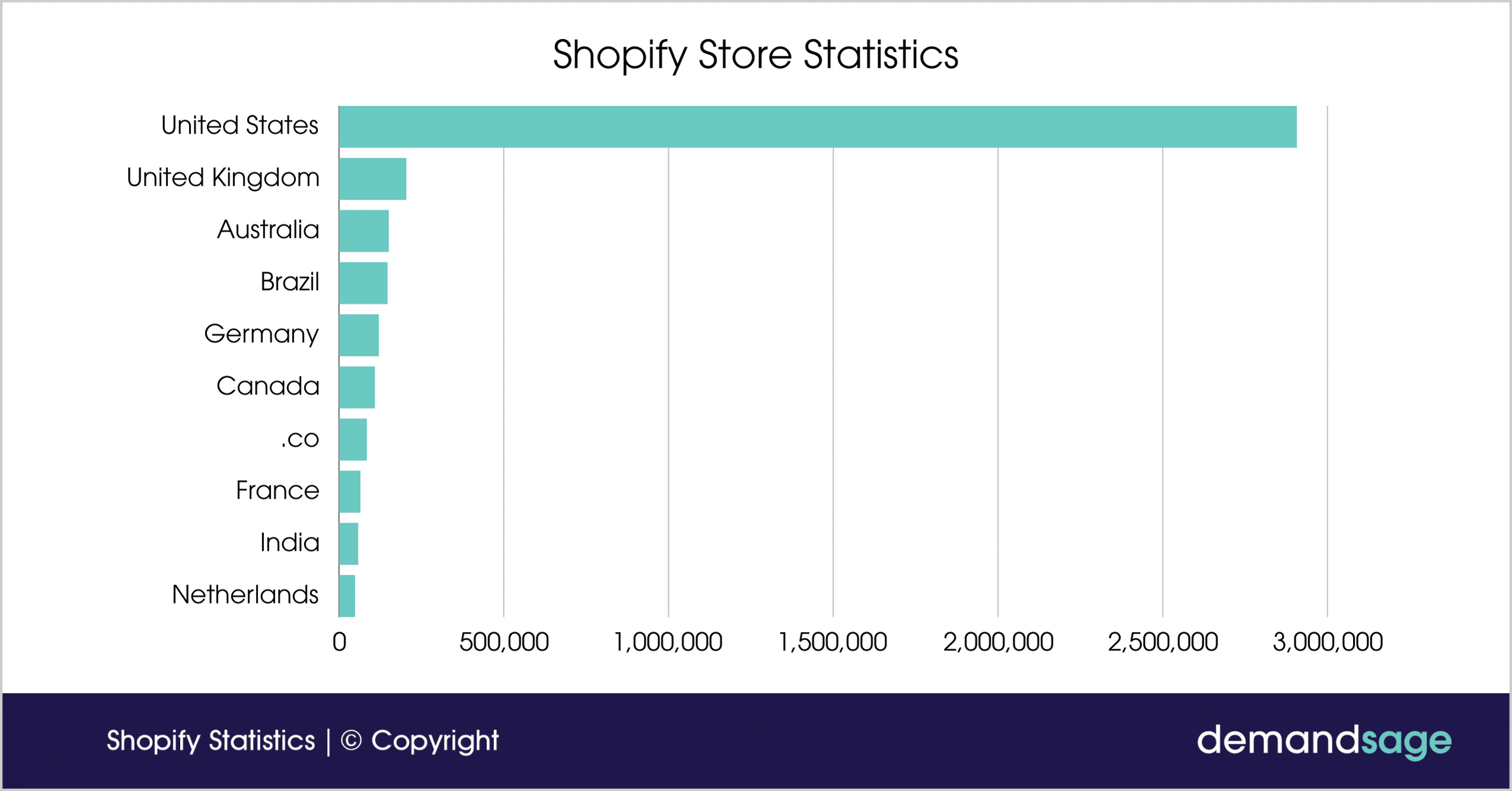
This table shows Shopify users by country as of 2024:
| Country | Number Of Live Shopify Stores |
|---|---|
| United States | 2,907,545 |
| United Kingdom | 204,754 |
| Australia | 151,151 |
| Brazil | 147,466 |
| Germany | 121,365 |
| Canada | 109,494 |
| .co | 84,596 |
| France | 65,540 |
| India | 58,771 |
| Netherlands | 48,942 |
Source: BuiltWith
Shopify Plus Store Statistics
Launched in 2014, Shopify Plus provides rapidly growing businesses with a personalized application framework at a low cost in terms of time, money, and innovation.
Shopify plus’ cost-effective, potent platform serves millions of enterprises globally, from startups to Fortune 500.
There are 48,426 Shopify Plus stores across 175 countries as of January 2024.
The United States has the most Shopify Plus stores (27,308 stores).
Here is a table showing the countries with the most Shopify Plus stores:
| Country | Share of Shopify + Stores |
|---|---|
| USA | 56.39% |
| UK | 6.84% |
| AU | 5.88% |
| CA | 5.69% |
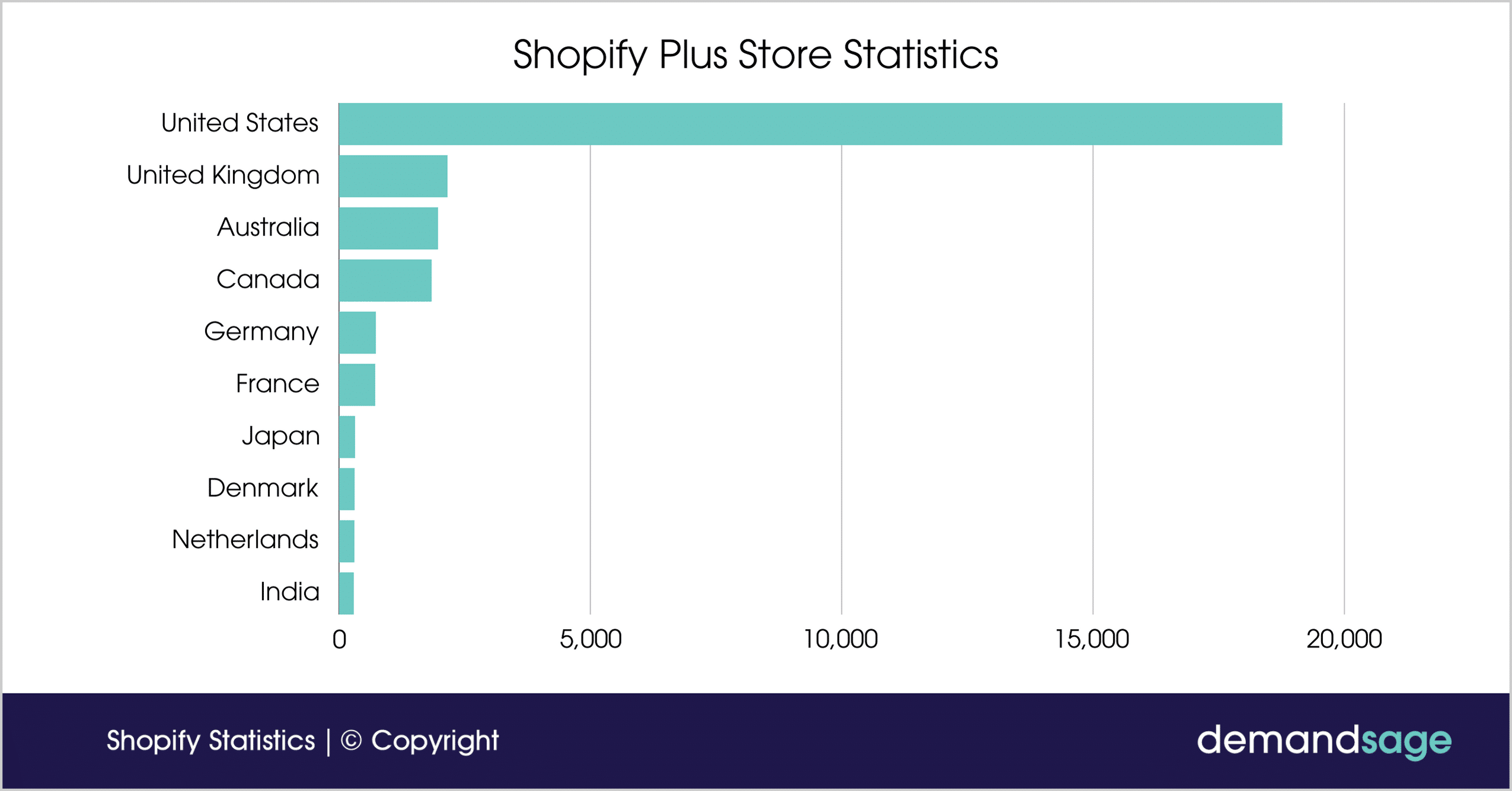
Here is the overview of Shopify Plus Stores by Nation:
| Country | Number of Shopify Plus Stores |
|---|---|
| United States | 18,767 |
| United Kingdom | 2,161 |
| Australia | 1,972 |
| Canada | 1,847 |
| Germany | 738 |
| France | 721 |
| Japan | 322 |
| Denmark | 314 |
| Netherlands | 307 |
| India | 295 |
Source: BuiltWith
Shopify Merchant Statistics
There are 1.75 million active merchants selling using Shopify.
With a count of 875,000, The U.S.A. accounts for 50% of the total Shopify merchants currently.
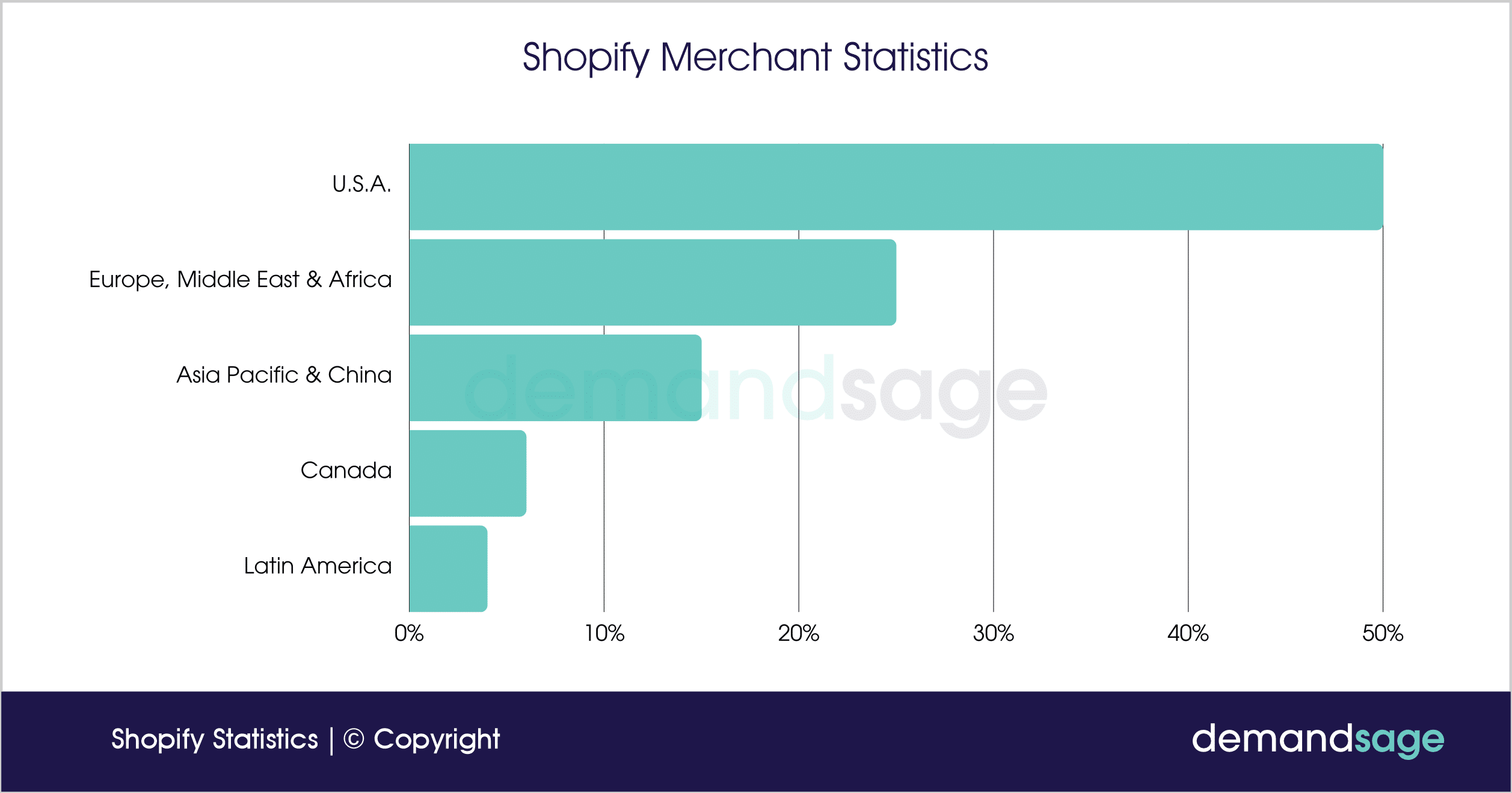
Here is a table showing the share of Shopify merchants in different world regions:
| World Region | Number of Shopify Merchants | Share of Shopify Merchants |
|---|---|---|
| U.S.A. | 875,000 | 50% |
| Europe, Middle East & Africa | 437,282 | 25% |
| Asia Pacific & China | 262,460 | 15% |
| Canada | 105,136 | 6% |
| Latin America | 70,111 | 4% |
Shopify Customer Statistics
It is predicted that Shopify sellers will have over 700 million customers in 2024.
Nearly 649 million people made a purchase from a Shopify store in 2022 alone.
For an idea, there are 2.14 billion people shopping online as of 2024.
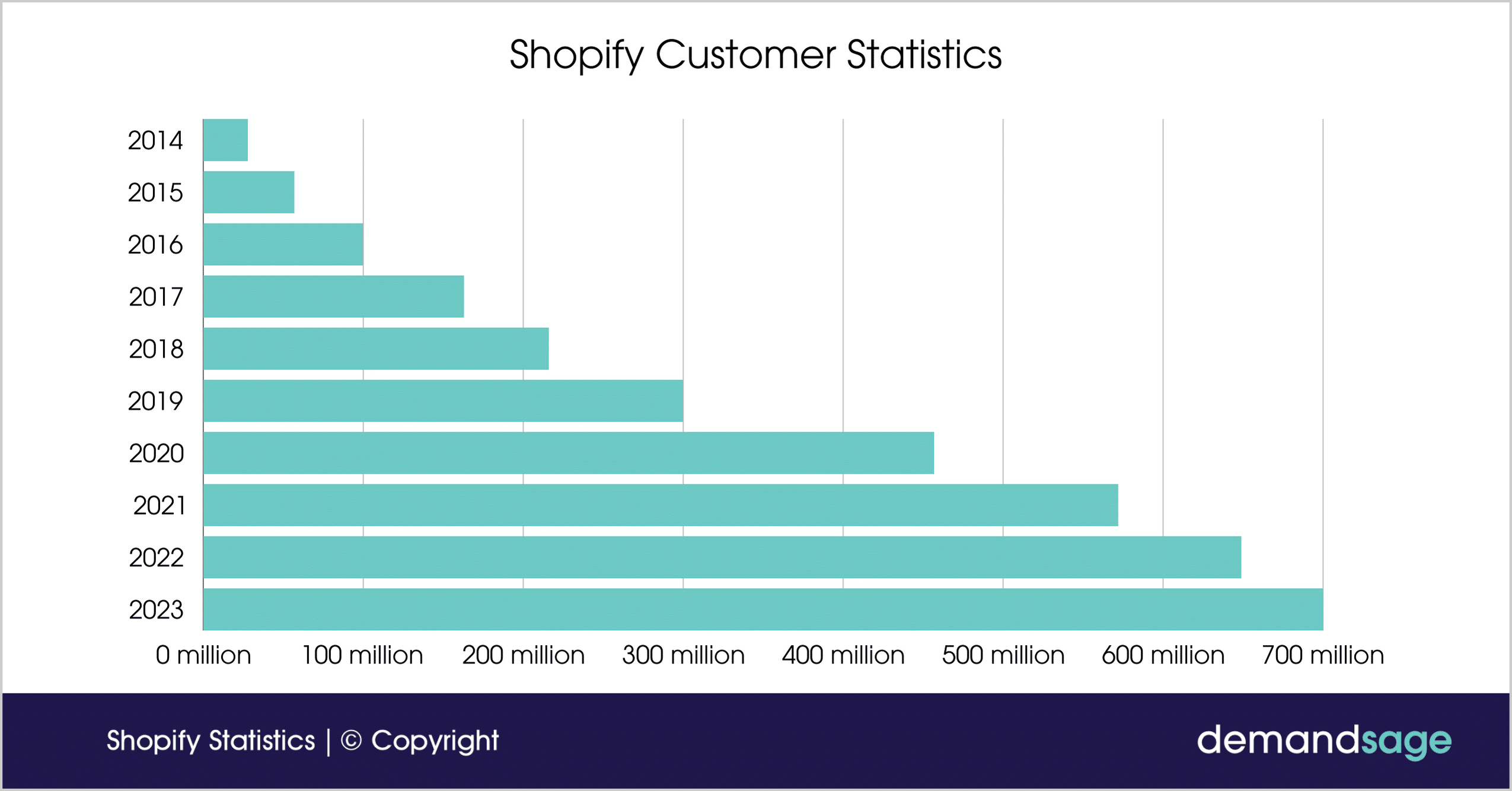
Here is the complete overview of Shopify customers over the years:
| Year | Buyers |
|---|---|
| 2014 | 28 million |
| 2015 | 57 million |
| 2016 | 100 million |
| 2017 | 163 million |
| 2018 | 216 million |
| 2019 | 300 million |
| 2020 | 457 million |
| 2021 | 572 million |
| 2022 | 649 million |
| 2023 | 700 million |
Shopify GMV (Gross Merchandise Volume)
Shopify’s gross merchandise volume is $160.8 billion as of the first three quarters of 2023.
Shopify’s GMV was $197.3 billion in complete 2022.
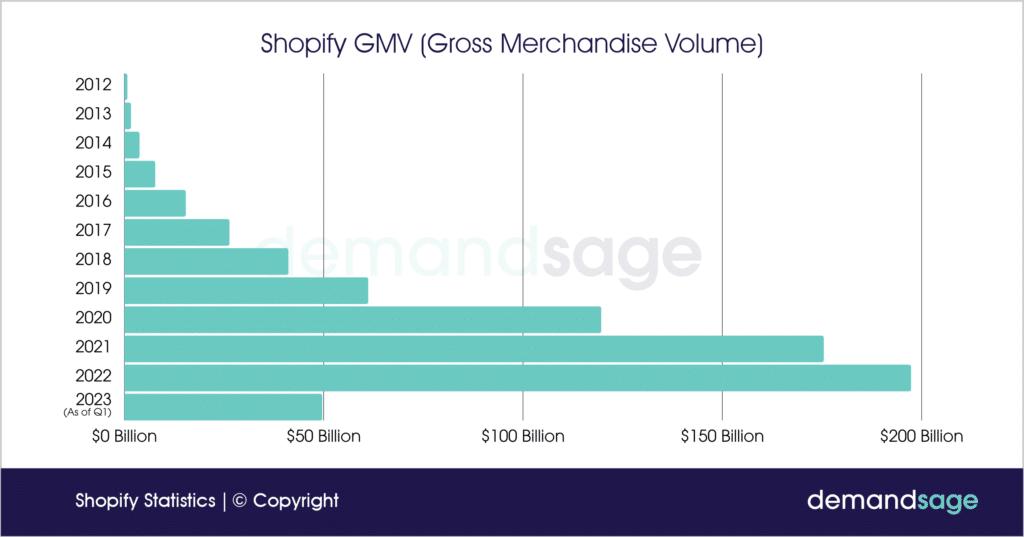
Here is the overview of Shopify’s GMV over the years:
| Year | Shopify GMV |
|---|---|
| 2012 | $707.4 Million |
| 2013 | $1.62 Billion |
| 2014 | $3.76 Billion |
| 2015 | $7.7 Billion |
| 2016 | $15.37 Billion |
| 2017 | $26.32 Billion |
| 2018 | $41.1 Billion |
| 2019 | $61.14 Billion |
| 2020 | $119.58 Billion |
| 2021 | $175.4 Billion |
| 2022 | $197.3 Billion |
| 2023 (As of Q3) | $160.8 Billion |
Shopify Financial Statistics (For The 1st Quarter of 2023)
- Shopify’s revenue increased by 25% yoy to $1.5 billion in the first quarter of 2023.
- Shopify’s Monthly Recurring Revenue is $116 million, which is up by 10% compared to the subsequent year.
- Subscription Solutions revenue increased by 11% year on year to $382 million.
- Merchant Solution’s revenue increased by 31% to $1.1 billion.
- Gross profit dollars increased by 12% year on year to $717 million.
- The operating loss for the first quarter of 2023 was $193 million.
- Shopify had $4.9 billion in cash, cash equivalents, and marketable securities as of March 31st 2023.
Shopify Financial Statistics (For The 2nd Quarter of 2023)
- Shopify’s revenue increased by 31% yoy to $1.7 billion in the second quarter of 2023.
- Shopify’s Monthly Recurring Revenue grew to $139 million.
- Subscription Solutions revenue increased by 21% year on year to $444 million.
- Merchant Solution’s revenue increased by 35% to $1.3 billion.
- Gross profit increased by 27% year on year to $835 million.
- The operating loss for the second quarter of 2023 was $1.6 billion.
- Shopify had $4.8 billion in cash, cash equivalents, and marketable securities as of June 31st 2023.
Shopify Financial Statistics (For The 3rd Quarter of 2023)
- Shopify’s revenue increased by 25% yoy to $1.7 billion in the third quarter of 2023.
- Shopify’s Monthly Recurring Revenue grew to $141 million.
- Subscription Solutions revenue increased by 21% year on year to $486 million.
- Merchant Solution’s revenue increased by 24% to $1.2 billion.
- Gross profit increased by 36% year on year to $901 million.
- The operating loss for the third quarter of 2023 was $122 million.
Shopify Revenue Statistics
Shopify registered a revenue of $4.9 billion in the first three quarters of 2023. Shopify consistently generated a revenue of $1.7 billion in the past couple of quarters.
Shopify generated a total of $5.6 billion in revenue in 2022.
This equates to a growth of 21% as compared to 2021.
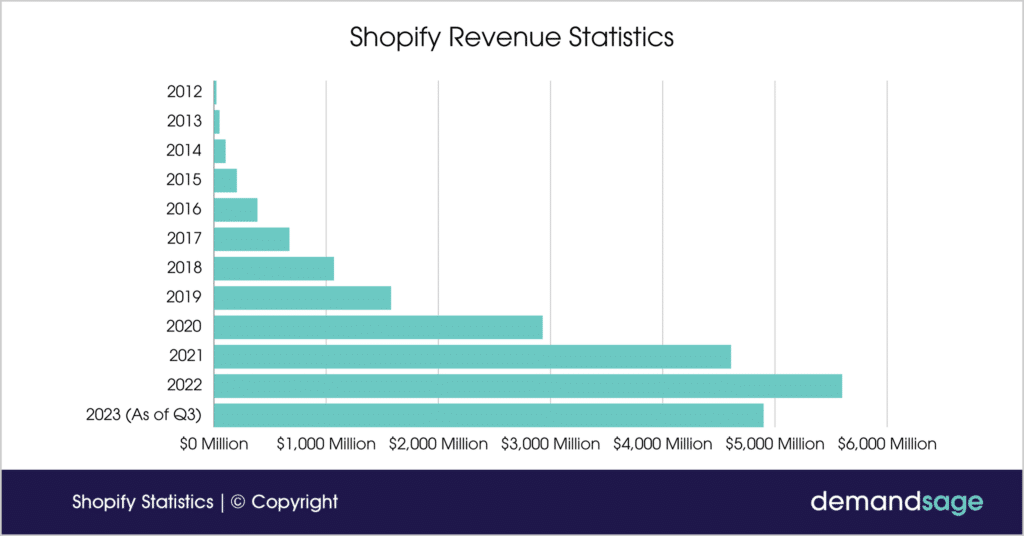
Here is the overview of Shopify’s revenue over the years:
| Year | Revenue |
|---|---|
| 2012 | $23.71 Million |
| 2013 | $50.25 Million |
| 2014 | $105.02 Million |
| 2015 | $205.23 Million |
| 2016 | $389.33 Million |
| 2017 | $673.3 Million |
| 2018 | $1.07 Billion |
| 2019 | $1.58 Billion |
| 2020 | $2.93 Billion |
| 2021 | $4.61 Billion |
| 2022 | $5.6 Billion |
| 2023 (As of Q3) | $4.9 Billion |
Subscription Solutions Revenue
All the fees associated with Shopify membership, POS, and sales of applications, themes, and domains fall under this category.
Shopify’s Subscription solution revenue was $1.31 billion in the first three quarters of 2023.
Shopify’s Subscription Solution Revenue was $1.5 billion in complete 2022.
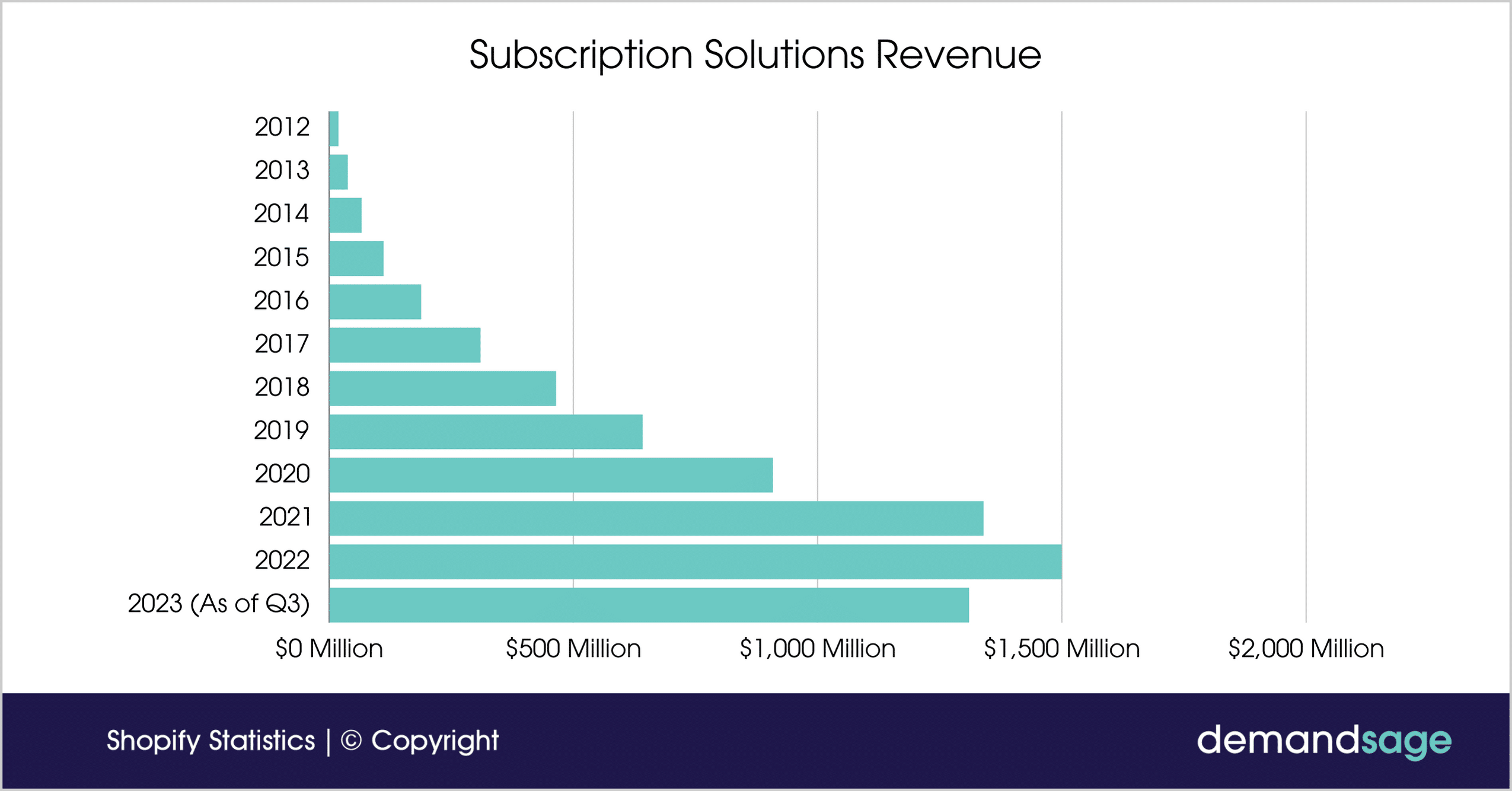
Here is the overview of Shopify’s Subscription Solution Revenue over the Years:
| Year | Revenue |
|---|---|
| 2012 | $19.2 Million |
| 2013 | $38.34 Million |
| 2014 | $66.67 Million |
| 2015 | $111.98 Million |
| 2016 | $188.61 Million |
| 2017 | $310.03 Million |
| 2018 | $465.00 Million |
| 2019 | $642.24 Million |
| 2020 | $908.76 Million |
| 2021 | $1.34 Billion |
| 2022 | $1.5 Billion |
| 2023 (As of Q3) | $1.31 Billion |
Here Is The Breakdown of Shopify’s Subscription Solution Revenue growth:
| Year | Growth % |
|---|---|
| 2012 | 80.98% |
| 2013 | 76.3% |
| 2014 | 63.48% |
| 2015 | 54.56% |
| 2016 | 48.44% |
| 2017 | 46.05% |
| 2018 | 43.46% |
| 2019 | 40.65% |
| 2020 | 31.01% |
| 2021 | 48% |
| 2022 | 11% |
Shopify Merchant Solution Revenue
Payment processing fees, Referral fees, advertising generated revenue & POS hardware sales make up this category.
Shopify’s merchant solution revenue in the first three quarters of 2023 was $3.6 billion.
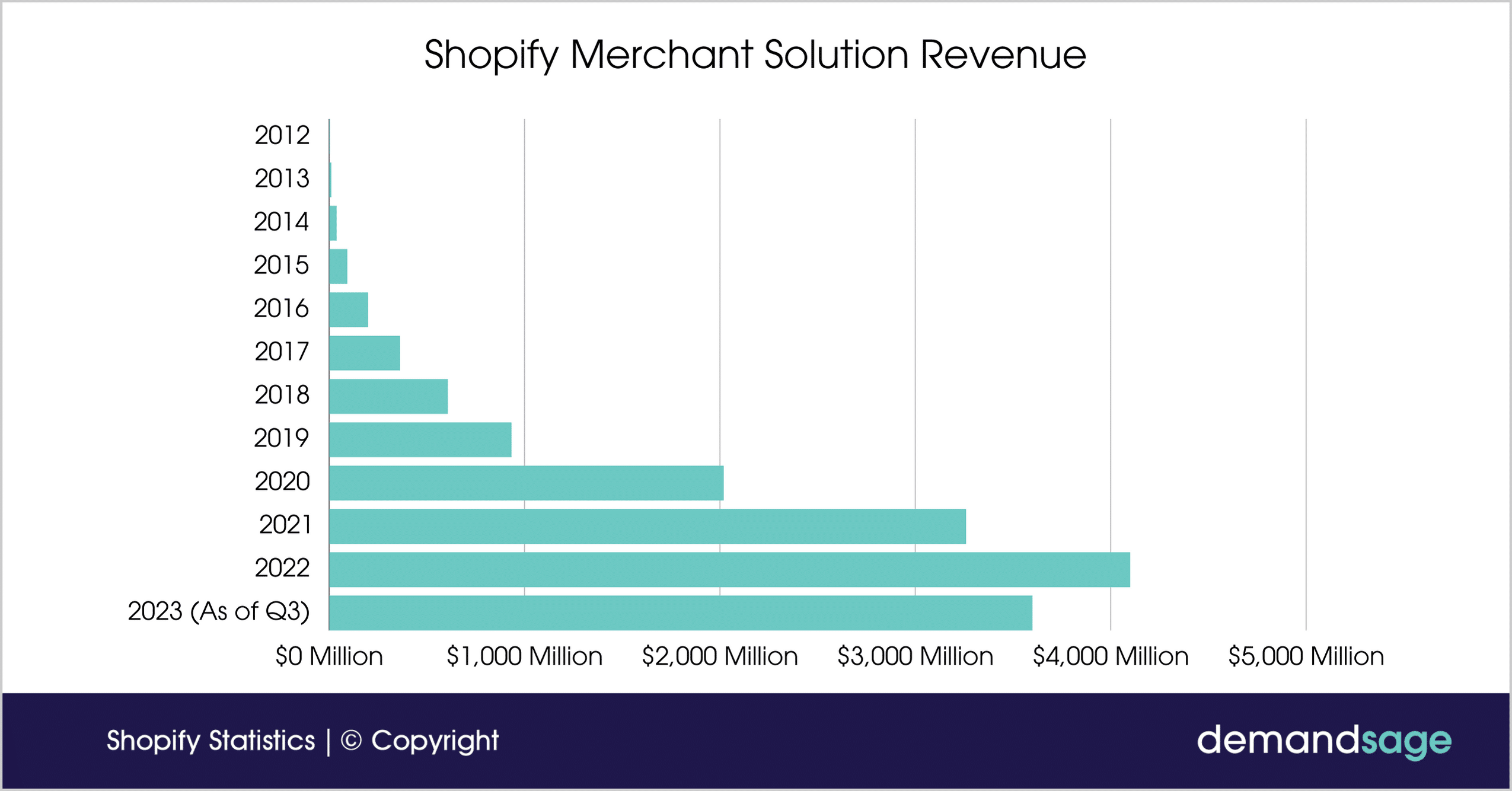
Here is the overview of Shopify’s Merchant Solution Revenue growth:
| Year | Revenue |
|---|---|
| 2012 | $4.51 Million |
| 2013 | $11.91 Million |
| 2014 | $38.35 Million |
| 2015 | $93.25 Million |
| 2016 | $200.72 Million |
| 2017 | $363.27 Million |
| 2018 | $608.23 Million |
| 2019 | $933.93 Million |
| 2020 | $2.02 Billion |
| 2021 | $3.26 Billion |
| 2022 | $4.1 Billion |
| 2023 (As of Q3) | $3.6 Billion |
Here is the overview of Merchant Solutions Revenue’s share in Shopify’s total revenue:
| Year | Growth % |
|---|---|
| 2012 | 19.02% |
| 2013 | 23.7% |
| 2014 | 36.52% |
| 2015 | 45.44% |
| 2016 | 51.56% |
| 2017 | 53.95% |
| 2018 | 56.54% |
| 2019 | 59.35% |
| 2020 | 68.99% |
| 2021 | 62% |
| 2022 | 73.21% |
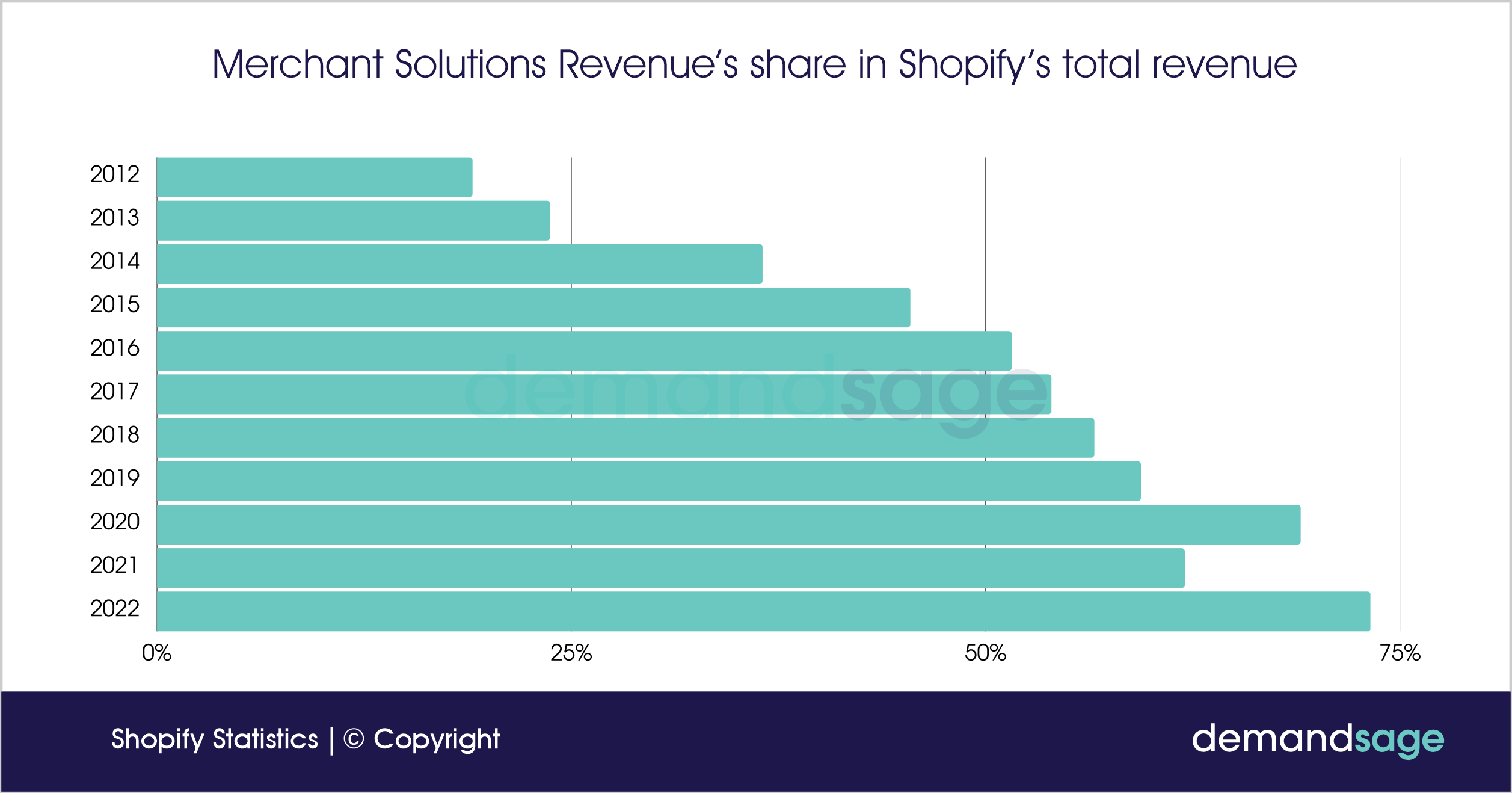
Bonus: If you want to start your online store, then you should get started with Shopify, and you can get up to 25% off on Shopify with our exclusive discount offer.
Shopify Revenue As Per Region
Shopify generated $2.15 billion US dollars in revenue from the USA, Canada, and Mexico, accounting for 73.3% of total sales.
$780 million is generated outside of the North American region.
Here is a table showing Shopify’s revenue in different world regions:
| Region | Revenue |
|---|---|
| North America | $2.15 Billion |
| Europe, Middle East & Africa | $454.27 Million |
| Asia Pacific & China | $292.24 Million |
| Latin America | $36.16 Million |
Here is a table showing the share of Shopify’s revenue in different regions of the world:
| Region | Share of Revenue |
|---|---|
| North America | 73.3% |
| Europe, Middle East & Africa | 15.5% |
| Asia Pacific & China | 10% |
| Latin America | 1.2% |
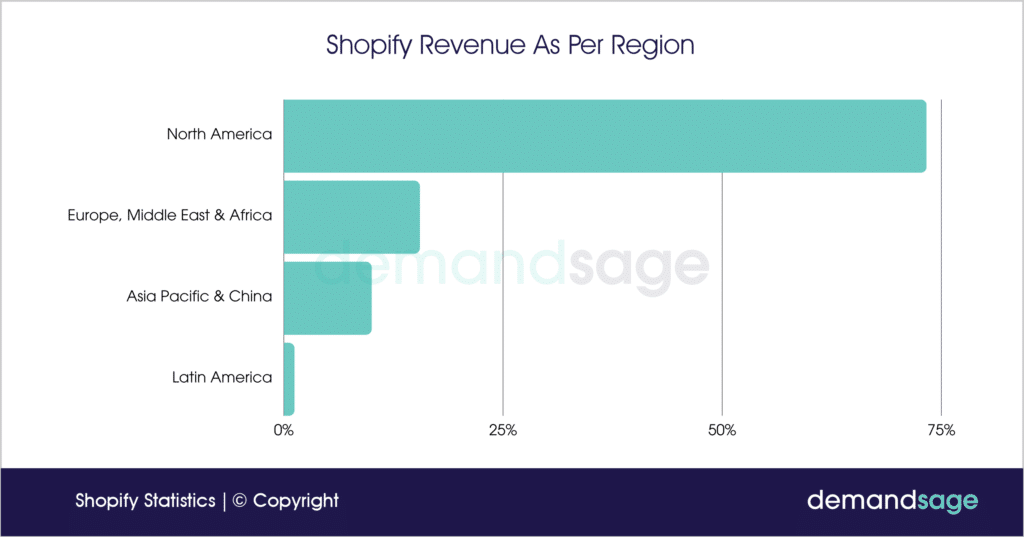
P.S. – This data is from 2022. We will update this section as soon as we get our hands on the latest figures.
Shopify Market Capitalization
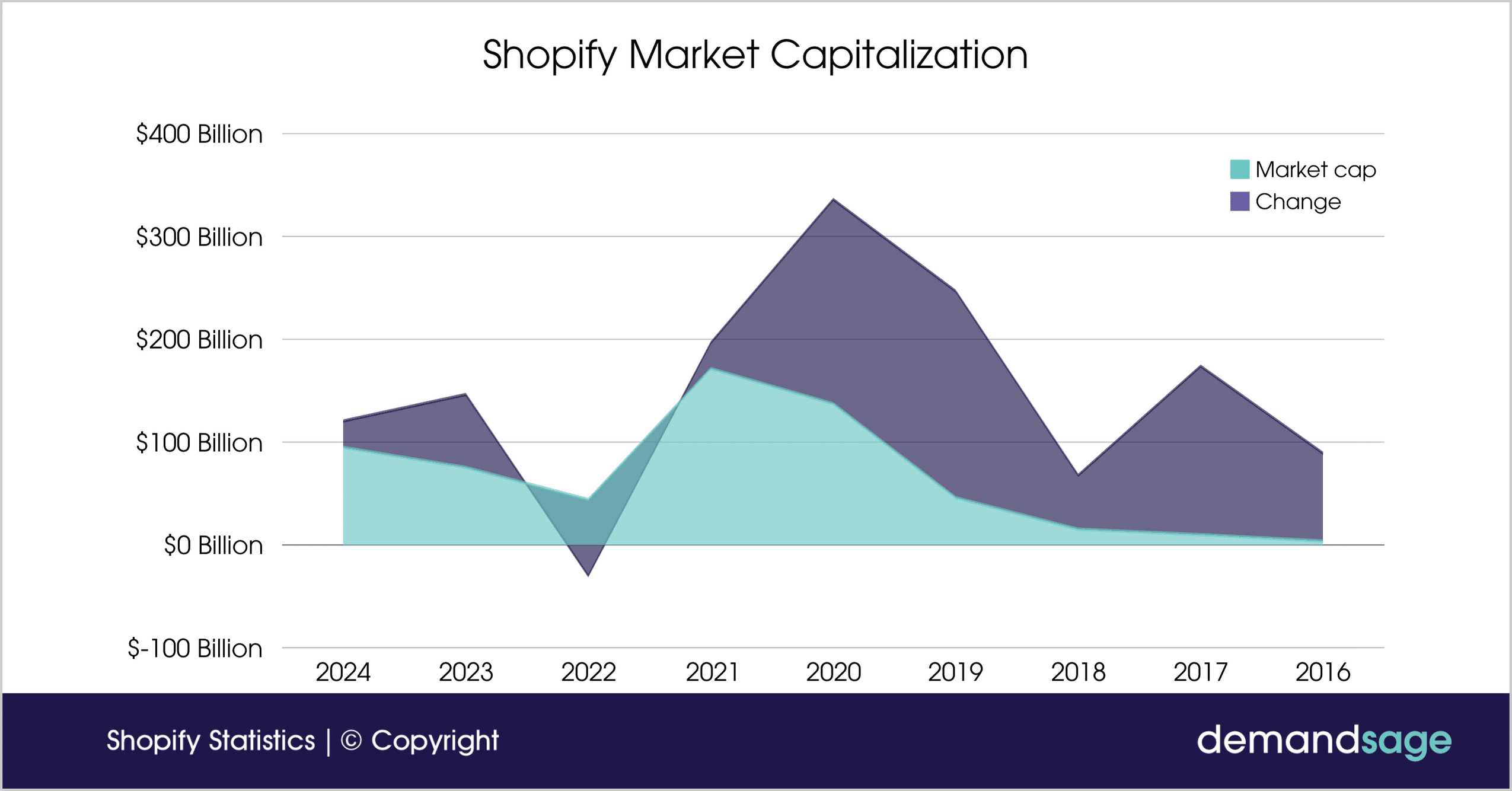
| Year | Market cap | Change |
|---|---|---|
| 2024 | $94.81 Billion | 25.70% |
| 2023 | $75.42 Billion | 70.82% |
| 2022 | $44.15 Billion | -74.26% |
| 2021 | $171.57 Billion | 24.86% |
| 2020 | $137.41 Billion | 198.61% |
| 2019 | $46.01 Billion | 200.74% |
| 2018 | $15.30 Billion | 52.39% |
| 2017 | $10.04 Billion | 163.81% |
| 2016 | $3.80 Billion | 85.25% |
Shopify Payments Statistics
Shopify Payments is the simplest way to accept payments online. It eliminates the hassle of setting up a third-party payment provider or merchant account and having to enter the credentials into Shopify.
Currently, Shopify payments are available in only 23 countries.
Here is the list of countries where Shopify Payments is available
- Australia
- Austria
- Belgium
- Canada
- Czechia
- Denmark
- Finland
- France
- Germany
- Hong Kong SAR
- Ireland
- Italy
- Japan
- Netherlands
- New Zealand
- Portugal
- Romania
- Singapore
- Spain
- Sweden
- Switzerland
- United Kingdom
- United States
Popular Categories on Shopify
Fashion is the most popular category on Shopify, with over 102,778 stores selling it. Apparel is the second most popular category, with around 105,636 stores. Followed by Apparel and Jewelry.
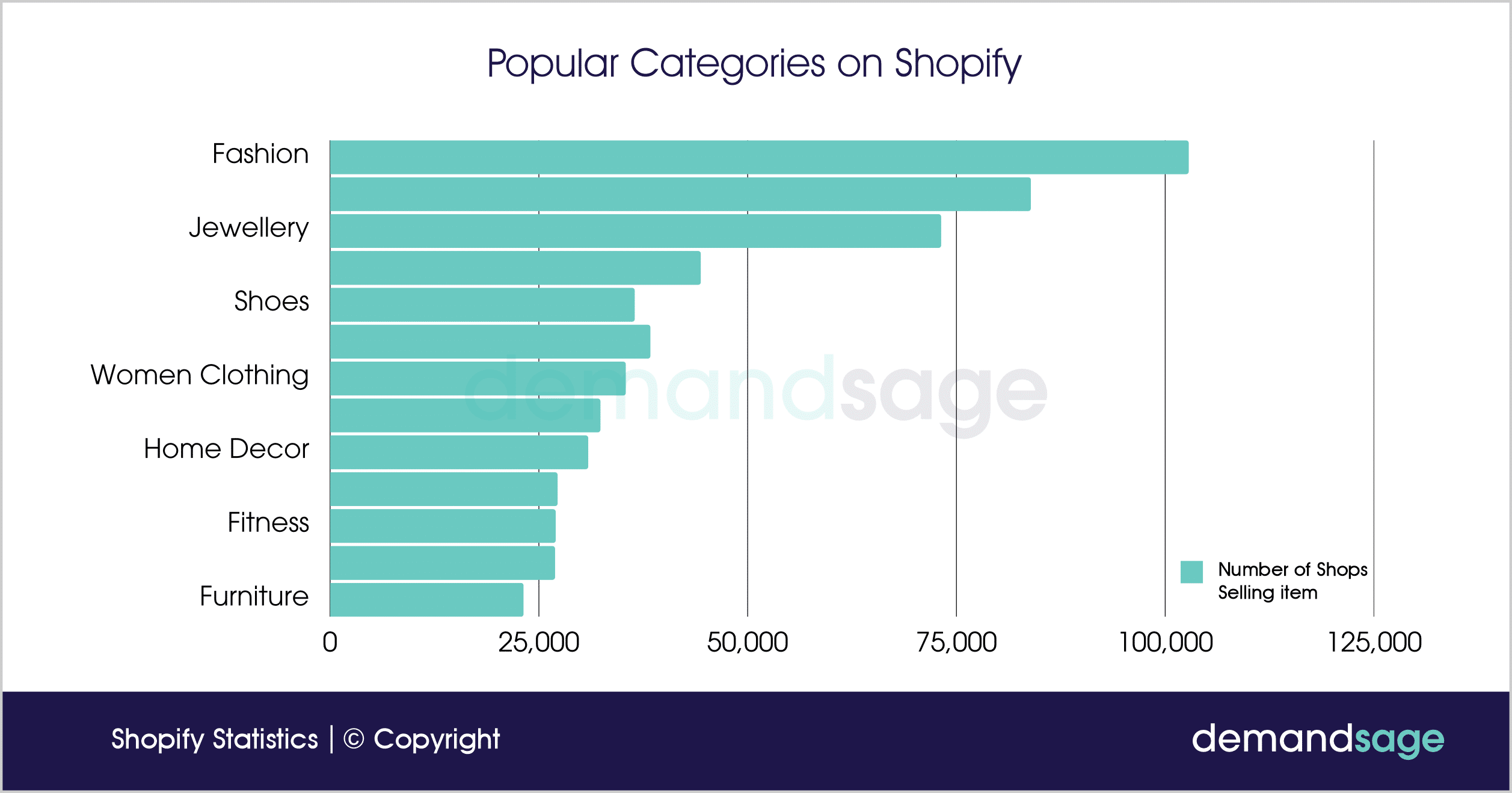
Here is an overview of Shopify’s most popular categories as of 2023:
| Category | Value |
|---|---|
| Fashion | 116,045 |
| Apparel | 91,948 |
| Jewellery | 77,874 |
| Bags | 47,424 |
| Shoes | 38,538 |
| Women’s Clothing | 36,541 |
| Makeup | 34,005 |
| Home Decor | 33,391 |
| Fitness | 31,464 |
| Coffee | 29,821 |
➤ Checkout our complete guide on how you can start selling on Shopify.
Shopify Application Statistics

The Shopify app store has 8000+ applications in a variety of categories to assist businesses in customizing their stores.
Each Shopify application goes through a 100-checkpoint review before it is released on the Shopify App Store.
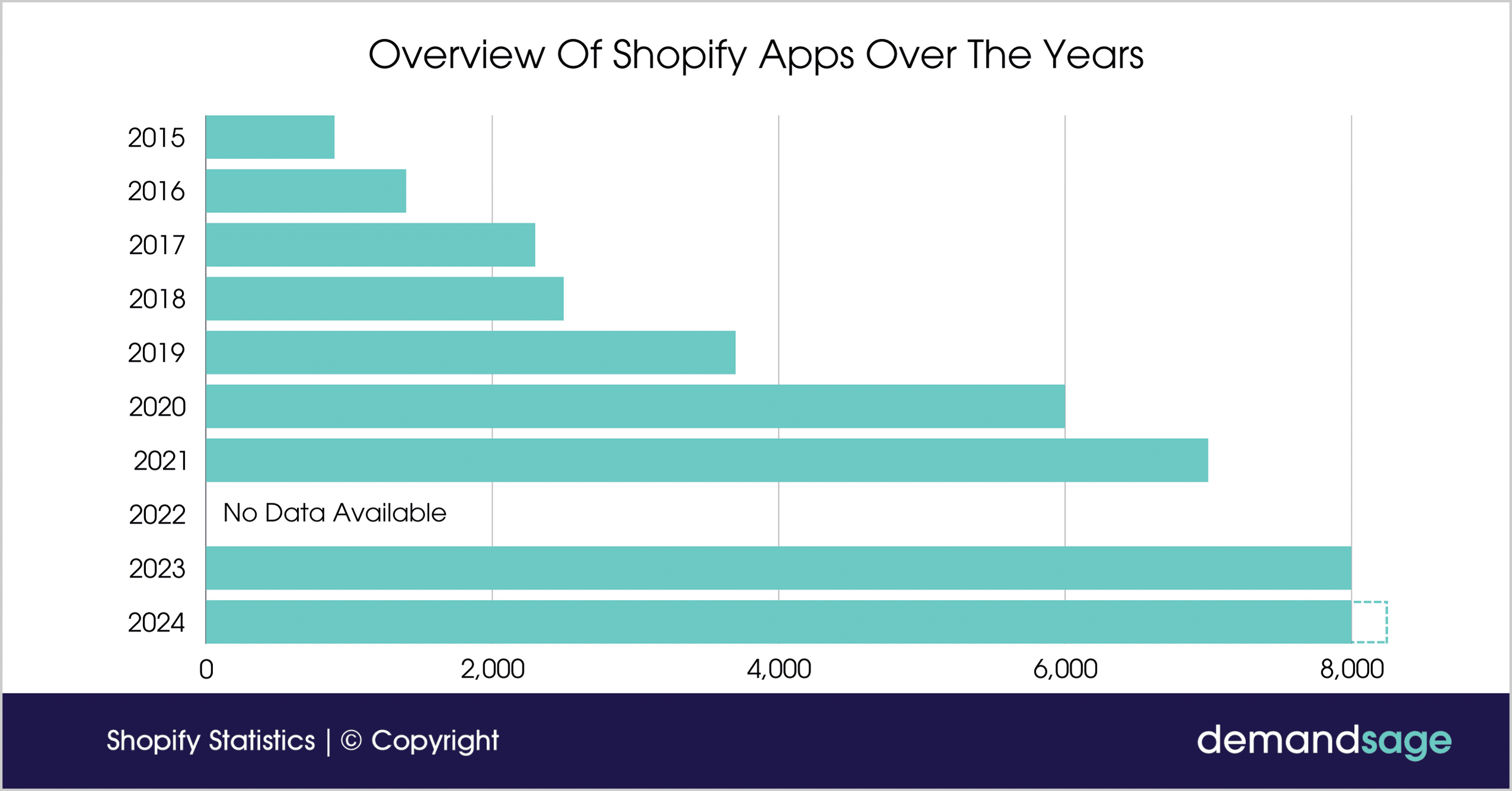
Here is the overview of Shopify apps over the years
| Year | Shopify Apps |
|---|---|
| 2015 | 900 |
| 2016 | 1,400 |
| 2017 | 2,300 |
| 2018 | 2,500 |
| 2019 | 3,700 |
| 2020 | 6,000 |
| 2021 | 7,000 |
| 2022 | No Data Available |
| 2023 | Over 8,000 |
Shopify Daily Active Users
Shopify stores get over 2.1 million daily active users in 2024.
However, this number can vary depending on the season and days of the week. For example, Saturdays/Sundays and vacations are peak times for Shopify stores.
The majority of Shopify Orders Come from Smartphones
Over 2 billion people are shopping online globally, and most of them are doing it from their smartphones.
This should serve as a wake-up call to all brands to make their websites mobile-responsive.
You may lose a lot of orders if buyers dislike your user interface or find it difficult to use on a smartphone.
Shopify gets a great number of referrals
Shopify receives a lot of referrals, which is a good sign for any e-commerce platform.
During 2021-2022, Shopify received over 35,000 referrals.
Over 50% of Shopify stores Receive Recurring Customers
Shopify customers carry out at least one more purchase on the platform after the initial purchase.
It is 3.8% possible that Shopify customers choose to shop from a shop that they have purchased from before.
Using 3D Images on Shopify Is Beneficial For Merchants
When using 3D product images on Shopify, conversions can be increased by up to 250 times.
Additional Facts and Figures Associated With Shopify
- Shopify has 270 points of presence around the world that ensure an incredibly fast experience for customers no matter where they shop.
- Merchants are 25% more likely to increase their conversions if they install the Shop channel and add the Shop Promise badge to their store.
Related Read:
- Shopify Free Trial
- Affiliate Marketing Statistics
- Chatbot Statistics
- Spotify Stats
- Shopify 1$ Dollar Offer
